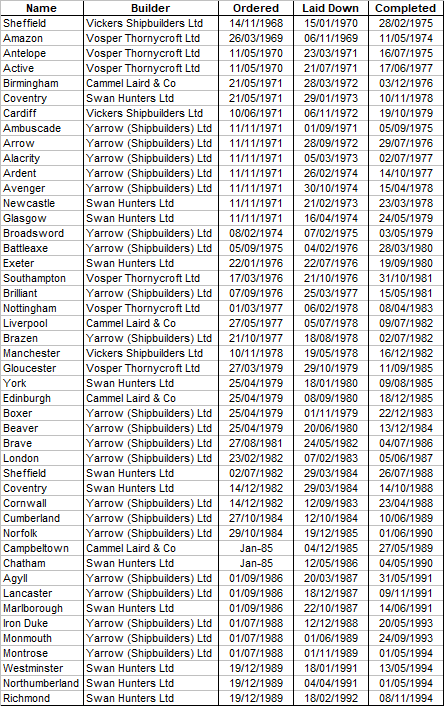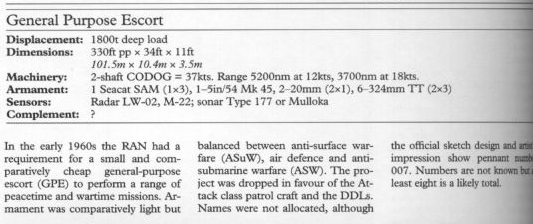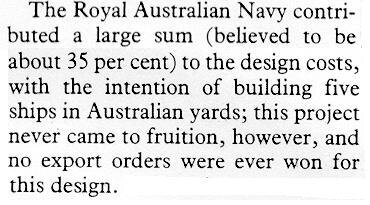- Joined
- 27 September 2006
- Messages
- 6,074
- Reaction score
- 6,188
The saga of the Royal Navy's carriers after 1966 has been the main focus of interest here, but the workhorse of the RN then as now was the frigate.
By the 1970s the RN had plans to replace its Type 12 Leander class frigates with the larger all missile armed Type 22.
Leanders were designed around a twin 4.5" gun for surface to surface and the combination of a Wasp helo and Limbo mortar for ASW. Anti aircraft defence was confined to the obsolescent Seacat.
The Type 22 was armed with Exocet SSMs and could carry two of the new Lynx helicopters. It could defend itself against aircraft and missiles with the Seawolf, a state of the art system.
Unfortunately such a change came at a high price. Initially only 4 Batch 1 Type 22s were ordered. They only began to be delivered as the 80s dawned.
The RN had to keep ordering frigates to maintain the UK's shipyards. Initially they kept building Leanders up until the 26th ship. Plans were made to re-equip the early ships with Ikrara ASW and then further ships with Exocet. Seawolf proved so cumbersome that only one launcher could be carried.
To maintain the UK's frigate building capability and allow older.ships to be retired, four Vosper Thorneycroft Type 21 frigates were ordered. With four more following these ships became the newest frigates in the RN until HMS Broadsword commissioned.
The Type 21s were able to carry both a 4.5" gun and 4 Exocets. Though critcised for poor habitability for ratings and their fragility undet fire, seven out of 8 ships went to the Falklands. Two were sunk.
The main weakness of the RN in the 70s was in the ageing Seaslug and Seacat anti-air missiles. Seadart equipped one trials ship- the sole Type 82 but by 1980 only a few of the new Type 42 destroyers had been delivered.
Even with hindsight it is hard to see how this leap (from Leanders to Broadswords) could have been handled better and faster, without more resources.
Sadly history repeated itself after 1991 with the T23 frigates having to serve even longer than the Leanders.
By the 1970s the RN had plans to replace its Type 12 Leander class frigates with the larger all missile armed Type 22.
Leanders were designed around a twin 4.5" gun for surface to surface and the combination of a Wasp helo and Limbo mortar for ASW. Anti aircraft defence was confined to the obsolescent Seacat.
The Type 22 was armed with Exocet SSMs and could carry two of the new Lynx helicopters. It could defend itself against aircraft and missiles with the Seawolf, a state of the art system.
Unfortunately such a change came at a high price. Initially only 4 Batch 1 Type 22s were ordered. They only began to be delivered as the 80s dawned.
The RN had to keep ordering frigates to maintain the UK's shipyards. Initially they kept building Leanders up until the 26th ship. Plans were made to re-equip the early ships with Ikrara ASW and then further ships with Exocet. Seawolf proved so cumbersome that only one launcher could be carried.
To maintain the UK's frigate building capability and allow older.ships to be retired, four Vosper Thorneycroft Type 21 frigates were ordered. With four more following these ships became the newest frigates in the RN until HMS Broadsword commissioned.
The Type 21s were able to carry both a 4.5" gun and 4 Exocets. Though critcised for poor habitability for ratings and their fragility undet fire, seven out of 8 ships went to the Falklands. Two were sunk.
The main weakness of the RN in the 70s was in the ageing Seaslug and Seacat anti-air missiles. Seadart equipped one trials ship- the sole Type 82 but by 1980 only a few of the new Type 42 destroyers had been delivered.
Even with hindsight it is hard to see how this leap (from Leanders to Broadswords) could have been handled better and faster, without more resources.
Sadly history repeated itself after 1991 with the T23 frigates having to serve even longer than the Leanders.










